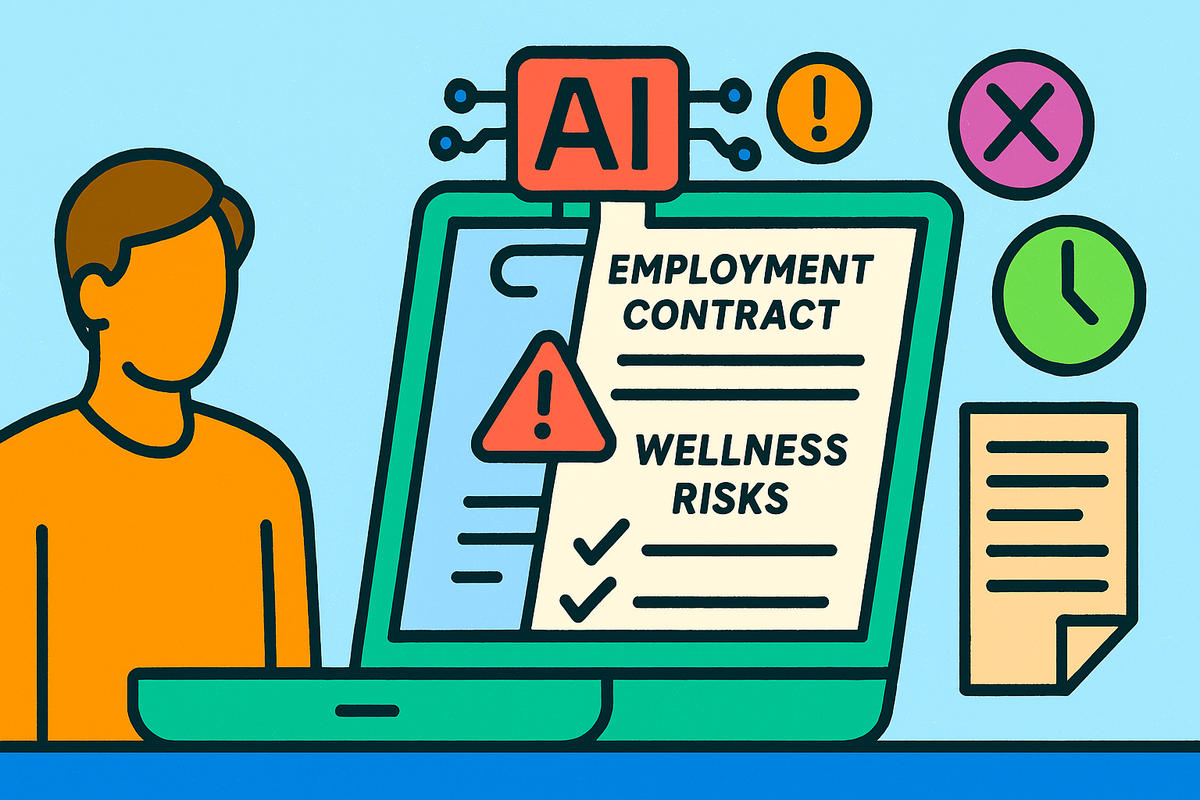Using AI To Make Employment Contracts Kinder to Workers

Employment contracts don’t set out to cause harm, but they’re often written with the employer’s needs front and centre, what they need protected, what they need flexible, what they can get away with.
That’s not malice, it’s more just inertia, we’ve normalised a load of terms that sound reasonable until they actually impact you:
“Available as needed.”
“Occasional unpaid overtime.”
“Restrictive covenant for 12 months post-employment.”
Standard phrases, copy-pasted into thousands of contracts, but they carry weight. They blur boundaries and they stack up.
Most legal teams aren’t reviewing these clauses through the lens of well-being. Most HR teams can’t easily spot what might become a retention issue six months down the line. Employees usually don’t have the context or confidence to challenge them, especially when we're in periods of high job demand.
So what if we used AI to scan contracts for wellness risk?
Not just is this enforceable? Is this fair?
We’ve already got tools that scan contracts for legal issues, they flag missing clauses, non-standard terms, indemnities that go too far, but these tools aren’t built to ask human questions.
What if your contract tool could flag:
- Clauses that increase burnout risk
- Terms that often lead to disputes
- Phrases that correlate with early exits
- Language that leaves too much unsaid
This isn't a crazy idea, the data already exists, the tools already exist. The gap is intent. Most of our current systems are wired for risk mitigation, rather than wellbeing, clarity or balance.
Why not build something that is?
What it could look like (practically, not hypothetically)
To be useful, this can’t just be a PDF scanner with a red/yellow/green light. It needs to understand contracts the way HR teams and employees actually experience them.
So here’s how we'd go about building this:
1. Start with clause segmentation that works
LLMs are good at this already. You run a contract through, and it breaks it into sections that matter:
- Hours
- Compensation
- Mobility
- Overtime
- Bonuses
- Post-employment restrictions
- Notice and termination
This isn’t just for neatness, it’s so we can isolate the real points of pressure.
2. Define your scoring axes
You don’t need some magic metric. Just define what you care about:
- Clarity: Is this clause clear, specific, and bounded?
- Balance: Does this push risk entirely onto one side?
- Burnout risk: Are the expectations reasonable over time?
- Career mobility: Does this limit future progression unnecessarily?
Not everything needs to score perfectly, but now we've got a language to talk about trade-offs.
3. Pull in real-world data
You can’t spot patterns without examples, we need to build on:
- Public tribunal outcomes
- Exit interviews and HR analytics (anonymised, obviously)
- Historic contracts linked to resignation data
- Guidance from ACAS, CIPD, employment case law
- Crowdsourced inputs (if you're feeling bold)
Now AI isn’t just comparing against policy, it’s learning from reality.
4. Suggest alternatives, not just flags
Highlighting issues is easy. Suggesting something better is harder, but far more useful.
So for each red-flag clause, offer rewrites that:
- Preserve the business need
- Add clarity for the employee
- Stay within the bounds of local employment law
- Reduce the odds of conflict later
So here's how it could look:
Original: “You may be required to work outside normal hours.”
Suggested: “Up to 10 hours of overtime per month may be required, compensated with time off in lieu.”
Suddenly it’s not just compliant. It’s actually reasonable and understandable.
Where this needs to be
Don’t make this another standalone product people forget to use, embed it where contracts actually happen.
- In BambooHR or Workday, for live reviews during onboarding
- In contract automation tools like Juro, HelloSign, or DocuSign as a pre-signature check
- In Microsoft Word via a sidebar plug-in for HR and legal to review templates as they edit
- In free to access tools on phones and online for the public to use
One click, one view with context-sensitive suggestions to show risk, impact and offer edits.
We could even show a "wellbeing rating" next to each clause, nothing formal, just enough to trigger a second look.
Who actually uses it?
This isn’t just for HR, there's value well beyond HR.
- HR gets proactive visibility over terms that cause issues down the line.
- Legal gets consistency and clarity without compromising enforceability.
- Employees get transparency and a fighting chance to ask questions before signing.
- Unions and regulators get data. Patterns. Trends. Evidence to push for better norms.
What might it change?
This isn’t about creating utopian contracts, some roles are tough and some expectations are high. However... clarity is free and fairness is possible.
If nothing else, you end up with fewer employees blindsided six months in.
If it takes off, maybe we finally stop pretending the only thing that matters in contracts is what’s legally enforceable. Maybe we start talking more openly about what’s sustainable, what’s equitable, and what kind of culture we’re actually building.
With this then maybe we can make employment contracts kinder by design, not just by accident.
If anyone is interested in looking at this problem I'd love to hear from you.